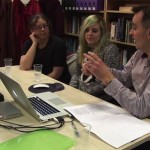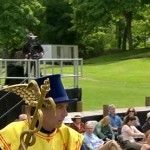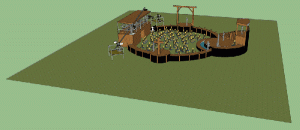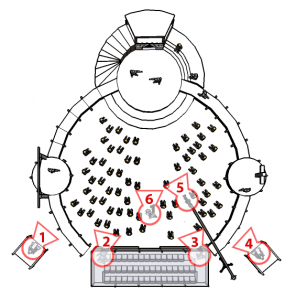The June 2013 performances were filmed by Richard Jack and his team at Enthuse TV & Events using six cameras. The ‘in the round’ staging placed the action around an amongst the audience, encircled by raised gangways linking a primary stage at the front with two secondary stages at left and right. Two cameras where placed on platforms on either side of the performance area, with a further two on either end of a gallery at the back. A mobile jib camera added height and flexibility and a mobile steady-cam provided an audience’s perspective.
What options does this set-up offer the film director and viewer?
Play the 17-second shot above which comes from the performance of Scene 8 of A Satire of Three Estates in which the Parliament meets. Shot with Camera 3, it is characterised by its closeness to the speaking character (Diligence) and exclusion of most other 19 characters on stage at that moment. It provides focus on the text whilst excluding physical context.
Now view the same moment in the performance from Camera 5 (Jib). How does being further back from the action affect your apprehension of the scene?
Camera 5
Now view it from camera 1 (Stage-right static camera on 1.2m platform) focussing not on Diligence but Rex Humanitas flanked by Divine Correction and The Parson. How does this shot add context to the text spoken by Diligence?
Camera 1
Now watch all six angles side-by-side and see what film director Richard Jack had to work with to put together his cut.
Finally, watch Richard Jack’s final cut of the scene. See how his choices visually follows and supports the script
 Alternative Versions Alternative Versions |
 video sequencer video sequencer |
 Introduction Introduction |








